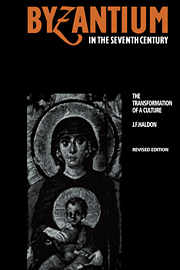Book contents
- Frontmatter
- Contents
- List of plates
- List of maps
- Preface and acknowledgements
- Preface to the revised edition
- List of abbreviations
- The sources
- Introduction
- 1 The background: state and society before Heraclius
- 2 The East Roman world c. 610–717: the politics of survival
- 3 Social relations and the economy: the cities and the land
- 4 Social relations and the economy: rural society
- 5 The state and its apparatus: fiscal administration
- 6 The state and its apparatus: military administration
- 7 Society, state and law
- 8 The imperial church and the politics of authority
- 9 Religion and belief
- 10 Forms of social and cultural organisation: infrastructures and hierarchies
- 11 Forms of representation: language, literature and the icon
- Conclusion: The transformation of a culture
- Addendum: Further observations on the question of the late ancient city
- Bibliography
- Index
11 - Forms of representation: language, literature and the icon
Published online by Cambridge University Press: 13 November 2009
- Frontmatter
- Contents
- List of plates
- List of maps
- Preface and acknowledgements
- Preface to the revised edition
- List of abbreviations
- The sources
- Introduction
- 1 The background: state and society before Heraclius
- 2 The East Roman world c. 610–717: the politics of survival
- 3 Social relations and the economy: the cities and the land
- 4 Social relations and the economy: rural society
- 5 The state and its apparatus: fiscal administration
- 6 The state and its apparatus: military administration
- 7 Society, state and law
- 8 The imperial church and the politics of authority
- 9 Religion and belief
- 10 Forms of social and cultural organisation: infrastructures and hierarchies
- 11 Forms of representation: language, literature and the icon
- Conclusion: The transformation of a culture
- Addendum: Further observations on the question of the late ancient city
- Bibliography
- Index
Summary
The literature and the art of the period we are concerned with represents one aspect of the social and cultural whole of the late antique and early medieval east Mediterranean civilisation which is the object of our enquiry. In itself it is, of course, a vast field which has been studied under a number of subcategories, and I shall not attempt a descriptive account of them all here.
My concern is rather with the ways in which these forms of representation functioned during the course of the seventh century in a way which has rendered them peculiarly difficult of access to later commentators. They were vehicles for the self-representation of the culture which produced them. They symbolised and transmitted, for different elements of the population, according to their means of access to them, fragments of an ideological system and a cultural universe. And at the same time, they constituted the shape of that cultural and symbolic universe, which we can observe both through these forms and through other sources.
These are normal and fundamental functions of artistic and literary production. But in the east Mediterranean world of the later sixth century and after, symbols that were culturally available evoked and were focused around specific aspects of that symbolic universe in a way which contrasts with that of the preceding years, a focusing which is part and parcel of the attempts at re-evaluation and reaffirmation discussed already in chapter 9. This is not to suggest that this process, at least in its main elements, was in any way one which was consciously undertaken or executed.
- Type
- Chapter
- Information
- Byzantium in the Seventh CenturyThe Transformation of a Culture, pp. 403 - 435Publisher: Cambridge University PressPrint publication year: 1990



